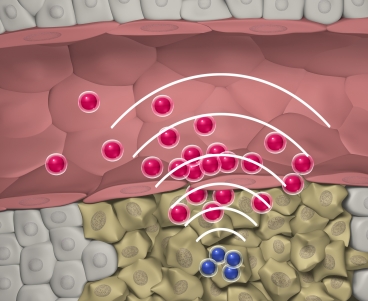A research team from MIT, Sanford-Burnham Medical Research Institute and the University of California, San Diego, developed a new kind of drug delivery system wherein a first nanoparticle wave targets the tumor and then calls for a much bigger second wave to infuse the cancer drugs.
The communication of nanoparticles between each other supported by the biochemistry of the human body enhanced the delivery of drugs to tumor cells by more than 40 fold as found in a study on mouse.
 nanoparticles communicating with each other inside the body to target tumors
nanoparticles communicating with each other inside the body to target tumors
Geoffrey von Maltzahn, a former doctorate student of MIT stated that the power of the nanoparticles to communicate among themselves in the human body makes it more effective for detecting and treating diseases such as cancer.
This approach finds roots in the blood coagulation cascade, a series of reactions that begin when a blood vessel is injured. During an injury, blood proteins also known as clotting factors join together in a complex structure to produce strands of fibrin that help in clotting blood. In order to find out the communication link in the cascade, two types of nanoparticles known as signaling and receiving particles were required.
Signaling particles are present in the first wave that leaves the bloodstream and reaches the tumor part through tiny holes in the permeable blood vessels that circles the tumors. These first-wave particles make the body to believe that an injury has taken place at a tumor site by either discharging heat or coalescing to a protein that favors the coagulation cascade. The second-wave receiving particles are covered with proteins that bind to fibrin, are attracted to the blood clotting area and are made to release the drug on reaching the tumor site.
A mice study showed that one particular system of communicating nanoparticles delivered 40 times more quantity of doxorubicin, a drug for treating several types of cancer, than non-communicating nanoparticles. A similar therapeutic result was found by the researchers on mice treated for tumor with communicating nanoparticles.